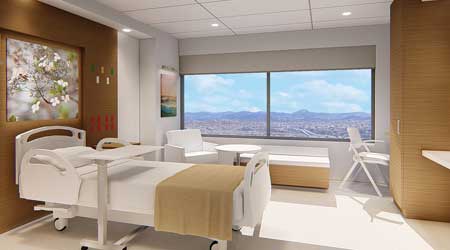 Creating a patient room that is inviting and well-organized, with technology that is controllable by the patient, provides a feeling of familiarity and home. Taylor Design
Creating a patient room that is inviting and well-organized, with technology that is controllable by the patient, provides a feeling of familiarity and home. Taylor Design5 Ways to Incorporate Sustainability in Experiential Design
Here are five best practices to implementing sustainability within the framework of experiential design in healthcare facilities.
Compared with other industries, healthcare is in a unique position because it has the ability to greatly influence manufacturers’ sustainability practices. Hospitals and other medical buildings are known to have special requirements in furniture, accessories, equipment and materials. This offers the opportunity to impact how these elements are constructed, sourced, or otherwise acquired. Healthcare facility owners and designers can dictate the look and feel of restroom accessories, flooring designs, and wallcovering patterns and colors.
With this in mind, facility managers, owners, designers, and other stakeholders can work together to re-imagine what people expect of the look and feel of hospitals. Getting there will require some changes to our approach and a great deal of creativity. Here are some guidelines that could help the healthcare industry successfully make the journey.
1. Follow an ethical compass around social and sustainable values. The USGBC’s LEED rating system can be a useful guide for sustainable practices, and LEED-certified buildings carry a level of green credibility. But achieving true success in sustainability for projects incorporating experiential design requires a greater commitment. This is because the act of creating a user experience often requires non-traditional practices that may not register on established sustainability guidelines.
Be responsible, transparent, and proud. Any good sustainability program takes into account material choices, and experiential design can play a role in identifying and promoting good practices. Facility users may prefer locally sourced materials over those that come from distant countries, so it makes sense to publicize the use of domestic or community-based materials. Experiential features that incorporate reusability, energy-neutral manufacturing or similarly responsible choices should not be kept secret.
2. Focus on the senses and treat the whole person. We know what materials and construction practices are sustainable, but we sometimes forget that sustainability is a state of mind as well. This aligns perfectly with the concept of “treating the whole person,” a succinct, but powerful statement. Successfully treating the whole person means that treatment must begin before a patient passes through the front door. Arriving at an unfamiliar place to meet unfamiliar people when you are not feeling well usually triggers fear and anxiety. But design can help to ease the apprehension with choices that delight the senses. For example, patients can be greeted by the sound of children’s laughter when a safe and colorful play structure is set near the entry area. Next, upon entering the lobby, they catch the scent of fresh flowers floating through the air, appealing not just to avid gardeners and other nature lovers, but anyone who appreciates the feeling of home. Lobby screens can accentuate the outside-in effect by featuring displays of nature, from what one might see just behind the facility walls to the roar of Niagara Falls or of a lion on the Serengeti.
3. Get the team on board and on the same page. To successfully implement experiential design that is consistent with appropriate sustainability standards, the design team needs to connect early, and agree on an approach that bridges the value of experiential design within the framework of a sensible, comprehensive sustainability program. This may include drawing on concepts and creations from other facilities, or even other industries. It also needs to consider the fact that major healthcare projects may take years to complete, so today’s decisions must attempt to look many months into the future. The key is to communicate early, openly, and with respect for the ideas and challenges of all stakeholders and team members.
4. Avoid getting hung up on cost. The hardest part of achieving this vision is avoiding the constraints of established practices, and instead adopting a bolder, more progressive mindset. This includes taking into account lifecycle cost and potential return of any expenditures, rather than focusing solely on the initial cost. What may appear on the surface to be a pricey undertaking has the potential to pay off handsomely if it helps to attract and secures the loyalty of one of the populations that will account for the vast majority of the population by 2030. These initiatives do not need to be expensive, but they should ideally be visible and effective.
5. Think big. One “blow-your-mind” feature may even be enough to help accomplish the overall goal of bridging experience with sustainability. For example, many hospitals have very long, often drab hallways that offer a great opportunity for an immersive experience, such as placing a series of LED screens that feature butterflies traveling along the hallway. The screens could include information about the butterflies’ habitat, threats, and other salient facts. It could serve as a beautiful and whimsical way to merge cultural differences, art, education, and global awareness, while showcasing sustainability and furthering the hospital’s business objectives.
Ultimately, all stakeholders in a healthcare project should have the opportunity to build into the design process a more robust conversation about creating unique immersive experiences that are tied directly to sustainable practices and messaging. There are amazing opportunities out there that don’t have to be cost prohibitive. It begins with a willingness to expand established boundaries and to gain an understanding of the value and return on investment that a well-planned, well-designed, and sustainable customer experience can deliver.
Stephanie L’Estrange is the interior design practice leader for Taylor Design, a strategy-based architectural design, interior design, and design strategy firm, with offices in northern and southern California.
Related Topics:












